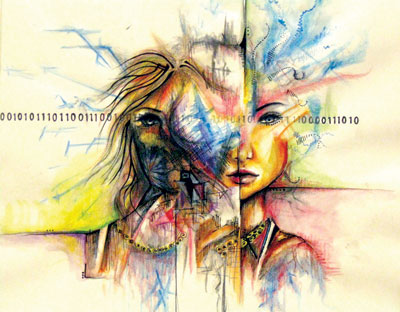All Nonfiction
- Bullying
- Books
- Academic
- Author Interviews
- Celebrity interviews
- College Articles
- College Essays
- Educator of the Year
- Heroes
- Interviews
- Memoir
- Personal Experience
- Sports
- Travel & Culture
All Opinions
- Bullying
- Current Events / Politics
- Discrimination
- Drugs / Alcohol / Smoking
- Entertainment / Celebrities
- Environment
- Love / Relationships
- Movies / Music / TV
- Pop Culture / Trends
- School / College
- Social Issues / Civics
- Spirituality / Religion
- Sports / Hobbies
All Hot Topics
- Bullying
- Community Service
- Environment
- Health
- Letters to the Editor
- Pride & Prejudice
- What Matters
- Back
Summer Guide
- Program Links
- Program Reviews
- Back
College Guide
- College Links
- College Reviews
- College Essays
- College Articles
- Back
Painting the Brain
Everyone has qualities that allow them to be classified into categories. Some individuals may be eccentric whereas others are more outgoing. This is simply a known fact of the human condition. However, certain traits have been known to attract certain colors. No scientific study has completely proved this true as of yet. There have been studies which lead to theories but a theory by definition is a testable idea. The question of color and psychology has become a more popular topic in recent years and we are coming closer to understanding the intentions of the brain.
According to Colormatters, many survivors of the Kobe earthquake in Japan cannot recall the event’s colors. They are only able to revisit the memory in black and white. Reasonably, surviving an event such as this can be traumatic and make one more paranoid when it comes to persona. It seems irrelevant that a change in the way we feel can consequently affect the color of our memories. However, the art world has historically associated stressful events with black and white and happy events with color. Published on the same website, a study done in Italy revealed that students given access to both black, white and color art materials expressed these same feelings with the corresponding color schemes.
Another psychological connection to color involves a color’s ability to arouse a certain mood. The colors in which we paint our rooms often reflect a preference. This impulsive choice is something not always considered when purchasing paint or other color products. We pick a color because we simply like it, but how does it make us feel on a deeper level? Colour-affects, supplies a list of eleven basic colors and the symbolism of the human condition associated with them. For example, blue represents intellect and green represents balance. A more creative person might prefer these colors without thinking about the connection to the stimulation of their brain. However, the idea of colors being attached to a human trait couldn’t have occurred without a hidden truth.
Melanie Burns, a psychological therapist at Methodist Family Health, observes adults and children with a variety of emotional and behavioral issues through her work. She is a firm believer in color psychology but in relation to the body’s chakras. “Some people believe our spiritual bodies are made up of seven different energy fields and these fields are all associated with different colors and different abilities,” says Burns on the idea. “When one of those centers becomes blocked, we may become physically ill.” These chakras include the Root, Sacral, Solar Plexus, Heart, Throat, Third Eye and Crown.
There are numerous chakra blocking factors. Natures-blessings, lists unreleased emotions, lack of love and taking oneself seriously as just a few of the causes of closure for any seven chakras. This means these factors result in less energy flow to the centers. Be that as it may, what if color was a primary cause of this closure? “My office walls at work are mustard yellow with overhead lighting like you would find in a bathroom and it about makes me sick,” says Burns. Her reactions to her office color relate back to the symptoms of a closed chakra she discussed: physical illness.
Also discussed on natures-blessings, are the ways in which you can heal and rebalance your chakras. Amongst these strategies is color healing. This is a process in which you visualize a peaceful color and allow yourself to focus it on the chakra you are currently having an issue with. This means that color can also be a source of healing and balance.
Color psychology still has its undiscovered depths. However, it has proved itself as a useful and capable subject of society. It can reflect humanity and allow everyone involved to find themselves. It can influence lifestyles by being the discreet cause of the choices people make. Most importantly, color has the ability to heal us and allows individuals to inhabit the best version of themselves. The human brain has been assisted by a silent companion for centuries and it now knows the identity.

Similar Articles
JOIN THE DISCUSSION
This article has 0 comments.
